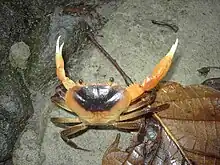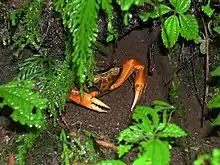Guinotia dentata
Guinotia dentata, commonly known as cyrique,[3] is a West Indian species of freshwater crab in the family Pseudothelphusidae.[4] They have few predators.[5] They are easily caught[3] and thus are used locally as a food source.[6]
| Guinotia dentata | |
|---|---|
 | |
| Scientific classification | |
| Kingdom: | |
| Phylum: | |
| Subphylum: | |
| Class: | |
| Order: | |
| Infraorder: | |
| Family: | |
| Genus: | |
| Species: | G. dentata |
| Binomial name | |
| Guinotia dentata (Latreille, 1825) | |
| Synonyms[2] | |
| |
Description
Guinotia dentata is almost oval in shape and the teeth on its carapace are very small. It is a yellow-brown colour and its shell can grow to 65 millimetres (2.6 in) long; it is about 3/5 long as wide.[3][6] The eyestalks are yellow whilst the corneas are black,[3] but they are probably best identifiable by their large yellow claws with straight sharply pointed fingers.[7]
The species sometimes has almost an entire dorsal surface of carapace yellow with submarginal brown.[8]
Its shell has a cervical meandering curve which does not quite touch the edge of the shell. About 24 cubicles are well defined. The forehead is low, excavated and depressed and of uniform height.[9] Its pereiopods are fairly average and its chelae are without prominent, swollen protuberance on outer surface near the base of the fingers.[8]
Distribution and habitat

The species is native mostly to Dominica, Guadeloupe, Martinique and Saint Lucia.[10] Its distribution is fragmented because of its presence on multiple islands, but it is plentiful in the regions it inhabits.[10]
Guinotia dentata lives mostly in streams (particularly shady ones)[5] and ponds and may sometimes be seen on land, though it avoids areas that are excessively dry.[4] It has not yet been observed in estuaries.[5] It lives in streams and rives in the highlands of the Lesser Antilles, not including the Virgin Islands.[10][11] They are known to hide under roots of trees, rocks and rotten wood where they dig shallow burrows which are oval in shape.[6][12] They have been spotted at altitudes of 2,850 ft (870 m).[3] They certainly inhabit the Boeri Lake and may inhabit Freshwater Lake.[13]
The largest threat to the species is habitat destruction, and a protected area has been established on Dominica to conserve them.[10]
Reproduction
Reproduction takes place entirely in fresh water, and breeding takes place all year round; there does not seem to be a breeding season.[5] The young undergo direct development, hatching as juveniles, without passing through any larval stages. The females carry the eggs and protect the young[6] who stay with their mother for a period after hatching.[5]
Diet
Guinotia dentata is a mainly carnivorous (though partially herbivorous)[6] animal which sometimes also acts as a scavenger or detritivore.[5] It has been observed to eat minnows, prawns, and aquatic algae-like vegetation.[14]
Taxonomic history
Guinotia dentata was first described in 1825 by Pierre André Latreille.[2] The specific epithet dentata means "toothed" in Latin.[5] In 1965, Gerhard Pretzmann erected the genus Guinotia (a tribute to Danièle Guinot) and made Latreille's species the type species.[15]
References
- Cumberlidge, N. (2008). "Guinotia dentata". IUCN Red List of Threatened Species. 2008: e.T134595A3983694. doi:10.2305/IUCN.UK.2008.RLTS.T134595A3983694.en. Retrieved 20 November 2021.
- Peter Davie (2009). "Guinotia dentata (Latreille, 1825)". WoRMS. World Register of Marine Species. Retrieved June 16, 2012.
- Kristy Venable (2004). "Photographic Guide to the Freshwater and Terrestrial Crabs of Dominica" (PDF). Texas A&M University. p. 16. Archived from the original (PDF) on August 10, 2014. Retrieved June 17, 2012.
- Richard G. Hartnoll (1988). "Biology of the land crabs: an introduction". In Warren W. Burggren; Brian Robert McMahon (eds.). Evolution, systematics, and geographical distribution. Cambridge University Press. pp. 6–54. ISBN 978-0-521-30690-4.
- Anne Prouzet & Pierre Noël (2009). "Guinotia dentata (Latreille, 1825)" (in French). DORIS. Retrieved June 17, 2012.
- Hans Hillewaert. "Guinotia dentata". BioLib. Retrieved June 16, 2012.
- Miculka (2009), p. 5.
- Chace & Hobbs (1969), pp. 156–160.
- Gilberto Rodriguez (1982). Les crabes d'eau douce d'Amérique. Famille des Pseudothelphusidae (PDF). Faune tropicale (in French). Vol. XXII. Paris: ORSTOM. pp. 188–192. ISBN 978-2-7099-0513-8.
- N. Cumberlidge (2008). "Guinotia dentata". IUCN Red List of Threatened Species. 2008: e.T134595A3983694. doi:10.2305/IUCN.UK.2008.RLTS.T134595A3983694.en.
- Chace & Hobbs (1969), p. 19.
- Miculka (2009), p. 7.
- Chace & Hobbs (1969), p. 42.
- Miculka (2009), p. 13.
- Gerhard Pretzmann (1965). "Vorläufiger Bericht über die Familie Pseudothelphusidae" [Preliminary report on the family Pseudothelphusidae] (PDF). Sitzungsberichte der Mathematisch-Naturwissenschaftlichen Klasse der Österreichischen Akademie der Wissenschaften, Wien (in German). 1: 1–11.
- Bibliography
- Brian Miculka (2009). "Burrowing habits, habitat selections, and behaviors of four common Dominican land crabs; Guinotia dentata, Gecarcinus lateralis, Gecarcinus ruricola, and Cardisoma guanhumi" (PDF). Texas A&M University. p. 16. Archived from the original (PDF) on August 10, 2014. Retrieved June 16, 2012.
- Fenner A. Chace Jr. & Horton H. Hobbs (1969). "The freshwater and terrestrial decapod crustaceans of the West Indies with special reference to Dominica" (PDF). Bulletin of the United States National Museum. 292: 1–258. doi:10.5479/si.03629236.292.1.
